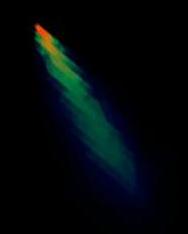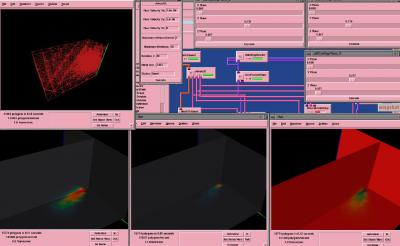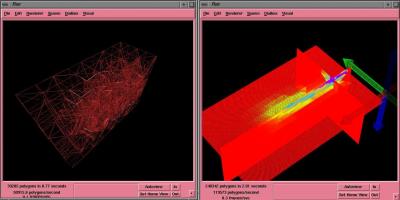Computational Fluid Dynamics
Computational Steering for CFD
Collaboration: Prof. Martin Berzins,University of Leads, UK; Dr. Steve Parker and Prof. Chris Johnson, University of Utah
 |
The application we consider here is taken from a model of atmospheric dispersion from a power station plume - a concentrated source of NO_x emissions. The photo-chemical reaction of this NO_x with polluted air leads to the generation of ozone at large distances downwind from the source.
An accurate description of the distribution of pollutant concentrations is needed over large spatial regions in order to compare with field measurement calculations. The present trend is to use models incorporating an ever larger number of reactions and chemical species in the atmospheric chemistry model. The complex chemical kinetics in the atmospheric model gives rise to abrupt and sudden changes in both space and time in the concentration of the chemical species in both space and time. These changes must be matched by changes in the spatial mesh and the time steps if high resolution is required.
The difference in time-scale between the reaction of these species leads to stiff systems of equations which require implicit numerical solvers and special linear equations solvers . The requirements of such a problem are that it is necessary to combine:
- Unstructured tetrahedral mesh generation and adaptation
- Physically realistic spatial discretisation methods.
- Stiff ode integrators tailored to the application.
- Fast interactive visualization for multi-species flow
- Computational steering facilities for transient problems.
The test case model covers a region of 300 x 500 km. and although far from a detailed, does represent the main features which would commonly be found in an atmospheric model including slow and fast nonlinear chemistry, concentrated source terms and advection The chemical mechanism contains only 7 species but still represents the main features of a tropospheric mechanism, namely the competition of the fast inorganic reactions The background concentrations listed by form the initial conditions for the model. These concentrations will then change diurnally as the chemical transformations take place. The power station is taken to be the only source of NO_x and this source is treated by setting the concentration in the chimney set as an internal boundary condition. In terms of the mesh generation this ensures that the initial grid will contain more elements close to the concentrated emission source. The concentration in the chimney corresponds to an emission rate of NOx of 400kghr^{-1} and only 10% of the NOx to be emitted as NO_2. We have assumed a constant wind speed of 5ms^{-1} in the x-direction with y and z components of one tenth of this value.
On the images below one can see: A dataflow network, showing modules (boxes), connections (wires) and the i/o ports on the modules that the wires connect). The plume and mesh shown are in the early stages of development. This picture shows one component of the plume in greater detail in three perpendicular cross-sections.
 |
 |
C.R. Johnson, M. Berzins, L. Zhukov, and R. Coffey
SCIRun: Application to Atmospheric Dispersion Problems Using Unstructured Meshes.
Proceedings of International Conference on Fluid Dynamics, Oxford, (1998)